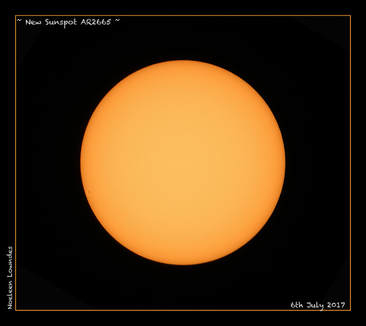The image was taken with a Canon 70D camera and a 70-200mm lens set at 70mm, the exposure time was 2.6 seconds and the ISO 800.
|
There was a pretty celestial triangle happening in the western sky tonight, with the 6 day waxing crescent Moon, Jupiter and the alpha star Spica all in the constellation of Virgo.
The image was taken with a Canon 70D camera and a 70-200mm lens set at 70mm, the exposure time was 2.6 seconds and the ISO 800.
0 Comments
I was out trying to capture an image of Jupiter at the same time (11th July 2017) as NASA’s Juno spacecraft was getting closer and closer to Jupiter’s GRS (Great Red Spot).
But unlike the Juno spacecraft, which was only a couple of thousand kilometres away from the planet, I was here on Earth at a distance of approx 700 million kilometres away with lots of turbulent atmosphere between the two of us…but it fun anyway, as there was a transit of the moon Europe traversing across the planets surface :-) To find out more about NASA’s amazing mission to Jupiter by the Juno spacecraft please go to: https://www.nasa.gov/mission_pages/juno/main/index.html Images taken with a Meade 10inch LX200 telescope at prime focus and a ZWO ASI120MC-S camera with a 2x Barlow lens attached, AVI movie file processed in Registak6 and PS CS4. You could still see this huge sunspot on the surface of the Sun even though there was lots of cloud racing across the sky, I only just managed to capture a couple of images before being completely clouded out…but I got my picture :-)
This is just one image taken with a Canon 70D camera and a Canon 100-400mm lens with a 2x converter attached. The camera has a glass solar filter attached to the lens, the exposure time was 1/320th second and ISO 400. It was so exciting observing the Sun today, while taking images with the Lunt H-Alpha solar telescope,
active sunspot AR2665 started to light up and go crazy with activity!!! There were also two very active prominences firing away on the eastern limb which were quite spectacular… Images taken with a 80mm Lunt solar telescope and a ZWO ASI120MC-S with 2x Barlow lens attached, AVI video files imported into RegiStax6 for stacking and processed in PS CS4. This is a composite image, one for the solar disc and one for the fainter prominences that were combined in PS. NASA's Solar Dynamic Observatory recorded the solar flare and the NOAA (National Oceanic and Atmospheric Administration) space weather map showed that I was right in the middle of this outburst in Australia.  ~ Sunspot AR2665 on the 8th July 2017 ~ ~ Sunspot AR2665 on the 8th July 2017 ~ New sunspot AR2665 is growing very fast and becoming quite active on the solar disc today, this image is just taken with a camera and lens setup on a static tripod. Images taken with a Canon 70D camera and a Canon 100-400mm lens with a 2x converter attached. The camera has a glass solar filter attached to the lens, the exposure times were 1/640 second and ISO 320, 12 images were stacked in Registak6 and lightly processed in PS CS4.  I got a surprise this afternoon, instead of seeing a completely blank solar disc, there on the eastern limb was a new sunspot, first of all I thought it was a spot on my camera chip, but moving the solar disc around in the frame showed it was still there! Later this afternoon I was pleased to see that Spaceweather.com updated their solar image to show this new sunspot designated AR2665, I think this one may be quite active as it’s growing quite fast... Images taken with a Canon 70D camera and a Canon 100-400mm lens with a 2x converter attached. The camera has a glass solar filter attached to the lens, the exposure times were 1/400th second and ISO 400, 15 images were stacked in Registak6 and lightly processed in PS CS4. At last I was able to capture an image of the beautiful planet Saturn in the night sky on the 1st July 2017. We have had so many wet weather systems passing through that it’s been nearly impossible to get an image,
but now I’ve go my picture, Yay!!! :-) At this very moment, Saturn’s magnificent rings are completely open and facing us here on Earth, with the planets northern pole displaying that incredible huge hexagonal weather system in its atmosphere, Yes, Saturn has amazing weather too! If you have a telescope, you must not miss taking your scope outside and having a look at this most beautiful planet in our solar system before it’s too late…. Images taken with a Meade 10inch LX200 telescope at prime focus and a ZWO ASI120MC-S camera with a 3x Barlow lens attached, AVI movie file processed in Registak6 and PS CS4. |
AuthorI just love being under the heavens, come on a journey with me and I’ll share some of the amazing wonders of the Universe with you. Noeleen :-) Archives
July 2024
Categories
All
|
